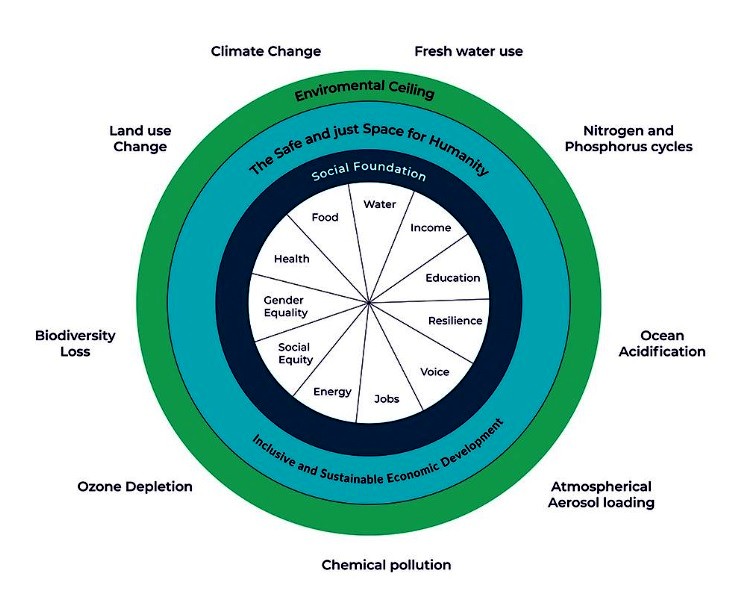Is there a way out of the climate crisis and could planetary intelligence be the answer? For years now, I have felt dread that climate change is threatening the survival of the human race and, perhaps. of nature itself. Hot weather makes me feel especially vulnerable: I have never been able to think when it gets over 90 degrees (32° Celsius). Temperatures remaining beyond 100 (38°) in the Southwestern US this summer rattle me with empathy fatigue, while here in Michigan 2.5 particulate matter from Canadian wildfires has me coughing.
Rabbi Harold Kushner, the author of several bestsellers including Who Needs God, notes that “watching a storm move across the land, pelting the earth with rain, lighting up the dark sky with lightning flashes” moved the Psalmist to realize “How great and mighty God must be to be able to create something like this.” The Psalmist finds the overwhelming capabilities of Nature not only as “humbling and comforting,” but also reassuring “that we are not the ultimate power. Our souls are so starved for that sense of awe, that encounter with grandeur which helps to remind us of our real place in the universe…”
When I was growing up along the Atlantic coast, the huge hurricanes and terrific nor’easters that fell upon us were often referred to as “Acts of God.” When I stood on our porch after a hurricane or shivered on the deck after a storm at sea, I would be filled with a reverent wonder totally different than what I have been feeling this summer.
These days, the droughts and the fires, floods, and hurricanes piling one upon the other fill me with guilty horror because neither God nor nature, but we ourselves, are responsible: these 100 mph winds, days-long rainstorms, and vast Canadian wildfires are the results of our own tragically flawed human decisions. Whether you are a secular humanist, like most of my friends, or believe that divinity is both immanent within and transcendent of nature, like I do, we are all ashamed that our beloved planet’s trajectory towards an unsustainable biosphere is the outcome of our own choices.
Planetary Intelligence
I usually shake myself out of climate despair by taking concerted action with as big and effective an environmental organization that I can find – in my case, the Citizens’ Climate Lobby, but my friends work at a variety of similarly results-oriented interest groups like the Sierra Club, the League of Conservation Voters, Climate Action, Interfaith Power and Light, etc.
Taking action used to leave me with a bit of hope, but now that one of America’s two parties is not only mired in climate denial but also intent on dismantling the climate legislation of the other, I have begun to wonder if our Climate advocacy can reverse climate warming in time.
When I heard the term “Planetary Intelligence” (PI) used to describe how Artificial Intelligence can achieve a worldwide synergy of climate mitigations, that bit of hope returned. Given my understanding that human reason and technology are in and of themselves value-free and that we apply them, for good or ill, according to values that we choose, I have begun to wonder if Artificial Intelligence might help us make better choices.
What would PI look like?
First of all, it would need to unify the disparate data presently residing in isolated silos that are not set up to communicate with each other. There are plans for mitigating climate change going on all over the lot, but the planners, who could richly benefit from each other’s input, don’t always talk to each other.
Getting these disparate schemes for planetary survival together in one global database could create a synergy (the Greek root is “synergos, or working together”), an advantageous conjunction of sustainability solutions.
Astrobiologists at Cambridge University see human cognition as but one among several aspects of Planetary Intelligence, extending their definition to all earth systems that “drive the planet” including the atmosphere and the hydrosphere. Though these atmospheric phenomena existed long before human beings evolved, our impact upon them has become part of our ecological disaster, so their workings must be taken into account in our attempts to reverse our errors.
The goal of the Cambridge Astrobiologists is a “planetary-scale collective cognition” that “brings with it the question: would planetary behaviour dominated by stabilizing feedback between awareness and consequences represent a new type or a new level of planetary intelligence?
If so, then our concept also takes on an aspirational quality. A deeper understanding of the transition to this mode could be useful for the project of building a sustainable global civilization (United Nations, 2015).”
In an article published on Live Science, titled Scientists say planetary intelligence is real, but Earth doesn’t qualify yet, science writer Harry Baker comments that at Cambridge a “ group of astrophysicists has proposed that individual planets are capable of developing intelligence — not the kind of smarts like knowing your ABCs, but rather an intelligence associated with the interconnectedness of the life inhabiting them. However, don’t assume that our planet is in this intelligent league. Earth is still one major step away from developing true planetary intelligence, a milestone that, if achieved, could help us prevent the impending climate catastrophe, the scientists said.”
Thus, while human technology has thrown planetary weather systems off balance, the balance can be restored and Planetary Intelligence achieved by humans synchronizing technologies with climate loops in nature:
“The researchers define true planetary intelligence as the point at which all the living systems on a planet work in unison for the benefit of the entire system. This would involve feedback loops in which negative changes to the planet, such as rapid climate change, are identified and counteracted.” (bolding added)
Planetary Intelligence Innovators
Turning to the practical matter of how this huge task might be accomplished, I have found a number of organizations that take it as their mission.
For example, The Climate PI is a company that aims to coordinate Artificial Intelligence on a worldwide basis, to enhance social and ecological good by synchronizing technology with the feedback loops of climate systems. The company was co-founded by Jeannie-Marie Larsen and Sarah-Louise Penall with the backing of Celine Cousteau, in hopes of creating a synergy amongst databases on a planetary scale.
In this diagram (inspired by economist Kate Raworth’s model of Doughnut Economics), Climate PI presents an outer circumference that includes non-human climate phenomena as earth systems that must be in balance in order to create an “environmental ceiling” sufficient to sustain human life at every social level.
As an advocate for Environmental Justice, I am encouraged that it is a key aspiration that must be built into applied technologies.

Another organization seeking better coordination of environmental mitigation is Climate-KIC. A knowledge and innovation community supported by the European Institute of Innovation and Technology, Climate-Kic aims to establish communication among environmental innovators.
Where Climate PI coordinates disparate databases focused on specific climate problems, Climate Kic organizes “change agents” to coordinate innovative start-ups and companies in “redefining innovation for climate action.”
By “taking a systemic approach across technology, infrastructure, economic models, capital flows and policy,” they hope to “locate the necessary levers to turn innovation into climate action.” As in the case of Climate PI, Climate Kic blends environmental with social justice goals: “to create a prosperous, inclusive, climate-resilient society founded on a circular, zero-carbon economy.”
You might have detected a pattern in these organizations: the need for human experts to collaborate across traditional boundaries.
The final group I will describe is an expert in this area: Trillium Technologies, which is an “impact-led social enterprise” whose mission is to synchronize academic and industrial resources “to accelerate the adoption of trusted intelligent systems for the benefit of humanity.”
In May of this year, Trillium held an Earth Systems Predictability Forum where “academics, institutional representatives and industry specialists came together to explore how the combination of Earth observation (EO) and artificial intelligence (AI) can inform data-driven decision-making on climate issues.” The forum included both the director of climate-KIC and of climate PI.
“AI can and does assist us with the considerable computational challenges associated with modeling Earth Systems,” concluded Jonathan Bamber, professor of Glaciology and Earth Observation at the University of Bristol and member of the ESA Advisory Committee for Earth Observation (ACEO). “Creating a sustained dialogue between experts in their respective fields will undoubtedly contribute to sealing and developing our predictive capabilities, and the ESP forum was an exciting and valuable step toward that goal.”
Reports from the ESP conference can be accessed at Calameo books.
Another consistent pattern emerging now is the use of decision intelligence, which is featured prominently in both Climate PI and Trillium’s materials. DI is the bridge between many breakthrough technologies and human decisions. It is essential in the Planetary Intelligence realm; we need the most advanced abilities that we have developed as a human species to solve our greatest challenges around climate change.
You can imagine how proud I am that my daughter, Dr. Lorien Pratt, invented DI and so is often invited to advise Planetary Intelligence organizations. Lorien spent some time this summer at our river cottage in Northwest Michigan, bringing her business with her, Quantellia, where she is the chief scientist. We swim in the river, we chat by the river, we walk along the river, we listen to the sounds of the birds and animals that depend upon the river, so rivers are in our thoughts a lot!
One of the things we mulled over this year was Planetary Intelligence. When I had a hard time getting my mind around it, Lorien put it this way:
“We have known all along that if we put something into a river it has effects downstream, but those downstream effects are mysterious: the river flows through marshes, is fed by a complexity of brooks and springs, and ultimately reaches Lake Michigan. It’s all a matter of what is called the knock-on effect when something causes other things to occur, sometimes indirectly.
You and I know that humans are wonderful at thinking and reasoning, but we need to be more aware of the downstream impacts of our actions. That’s why DI is so important in rescuing our planet: it helps us understand how even the smallest climate change actions flow through time and space so that we can grasp the full impact of the ripple effects through the whole watershed, from the headwaters on down.” (bolding added)
 In early September, when my family and my guests had all left the cabin, I sat down by the river to think about environmental actions and writing I might undertake this Autumn. As so often, climate warming seemed overwhelming, rushing at us to threaten inevitable destruction.
In early September, when my family and my guests had all left the cabin, I sat down by the river to think about environmental actions and writing I might undertake this Autumn. As so often, climate warming seemed overwhelming, rushing at us to threaten inevitable destruction.
Just then, something detached itself from the long green river grasses streaming in the current. Slim and almost entirely transparent, it was the smolt of the Steelhead Trout, practicing invisibility to feed on the river bottom.
Maybe we, who have made so many mistakes and who seem so fragile in the face of their consequences, can hold our own against the current after all?
Editor’s Note: The opinions expressed here by Impakter.com columnists are their own, not those of Impakter.com. Featured Photo: Effects of climate change and global warming Photo by: Marco Verch Professional Photographer.










